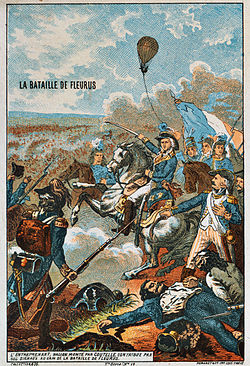Compagnie d'Aérostiers
| French Aerostatic Corps | |
|---|---|

Aerostatic Corps balloon during the Battle of Fleurus
|
|
| Active | 1794–1799 |
| Country | France |
| Type | Balloon engineers |
| Role | Reconnaissance |
| Size | Two companies of 26 soldiers |
| Colors | Blue with a black trim |
| Engagements |
Battle of Fleurus, Battle of Mainz, Battle of Würzburg, Battle of the Nile |
| Commanders | |
| Notable commanders |
Jean-Marie-Joseph Coutelle, Nicolas Lhomond |
| Aircraft flown | |
| Reconnaissance | L'Entreprenant, Hercule, L'Intrépide |
The French Aerostatic Corps or Company of Aeronauts (French: compagnie d'aérostiers) was the world's first air force, founded in 1794 to use balloons, primarily for reconnaissance.
Numerous suggestions had been made for the use of balloons during the French Revolutionary Wars, and in 1793 the Committee of Public Safety began testing their potential. Initial tests of airship designs proved unsatisfactory. However, experiments conducted near the Tuileries from September to October 1793 to produce the required hydrogen without the use of sulphuric acid, which was in short supply, were successful, producing more than 20 cubic metres. As a result, the Committee determined to use this technique to float tethered balloons.
At the end of October 1793, chemist Jean-Marie-Joseph Coutelle and his assistant, the engineer Nicolas Lhomond, were sent to join the Army of the North, with 50,000 livre to acquire equipment. They were given a letter from Lazare Carnot commending them to General Jean-Baptiste Jourdan and representative Ernest Dominique François Joseph Duquesnoy, which informed them that "Citizen Coutelle is not a charlatan". However, on arrival, Jourdan ridiculed the project, ordering Coutelle back to Paris, with the message that an Austrian attack was imminent, and a battalion was required, not a balloon.
Back in Paris, the Committee of Public Safety ordered further tests on the balloon technology, to be conducted at the Chateau de Meudon, where the Aerostatic Development Centre was founded. Nicolas-Jacques Conté led the research, refining balloon shapes and materials, and also improving the hydrogen production process. This culminated in a series of ascensions, viewed by leading figures on the Committee, who passed an Act creating the Aerostatic Corps on 2 April 1794. The corps consisted of a captain and a lieutenant, a sergeant-major and sergeant, two corporals and twenty privates. All these men were required to have skills relevant to ballooning, such as chemistry or carpentry. The Act creating the corps envisaged three roles: reconnaissance, signalling and the distribution of propaganda. Coutelle was created captain, and Lhomond lieutenant.
...
Wikipedia
